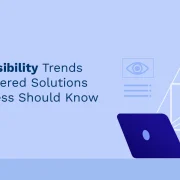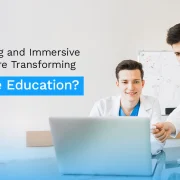How to Make Accessible Courses for Higher Education Students
Advancing technology has made it possible to design accessible courses for higher education students. That said, it is important to first understand the term accessibility. The term accessible in the context of accessible courses means that students with disabilities can engage and interact with the content in a way similar to the students without disabilities. In other words, people with disabilities should be able to obtain complete access to the content independently and equally as people without disabilities.
Content developers can leverage assistive technology to design accessible courses for higher education students. For instance, videos should be captioned for those who suffer from hearing disabilities and there should be audio for the visually impaired.
Similarly, visually impaired students should be able to access content using screen reader technology. If the PDF is simply a scanned image, the screen reader technology will not be able to read it. Then again, students with dyslexia have limited abilities to read the printed word and need access to assistive technologies that allow them to view the word and also hear it at the same time. These are a few examples of challenges faced by children with special abilities and how technology can be used to overcome them while designing accessible courses for higher education students.
The Americans with Disability Act (ADA) of 1990 also mandates inclusive accessibility including online educational opportunities. The Act, therefore, requires that all online courses for higher education students have to be accessible.
Also Read: How to Make Your Website ADA/WCAG Compliant
While online instructors spend a lot of time designing courses that foster academic excellence in their subject area, they also need to be aware of the simple strategies that can make their courses ADA-compliant, and hence, accessible to all.
In this article, we look at how to design accessible courses for higher education students.
Easy-to-read Font
Sans serif is the ideal font style to use to design accessible courses for higher education students. This is because, unlike fonts such as Times New Roman and Palatino, Sans Serif does not have additional strokes attached to the letters. Sans Serif font style includes Arial and Helvetica. Once you have decided upon the font style, ensure consistency of use throughout the course. This is because by minimizing font variation, or any other type of variation, you can ensure greater focus on the content.
Color Contrast for Text
Another factor to consider is text design. For better usability and accessibility, use a dark-colored font on a light background. Also known as high contrast, the ideal text design method is to use black font on a white background. However, you can use any other color – the only thing to keep in mind is to avoid the use of extremely bright background colors such as yellow and red. Other combinations to avoid are red and green, and yellow and blue. This is because students with color blindness would not be able to differentiate the text from the background.
Also Read: 5 Reasons Why Enterprises Need to be WCAG Compliant
Keep Text Formatting Simple
The next option to examine in designing accessible courses for higher education students is text formatting. The thumb rule is to follow the ‘less is more’ approach. Avoid unnecessary use of bold and italics. Also, only underline content that is to be hyperlinked. As with text design and font, variations will discourage students with disabilities to engage with the content. Besides, it will take away attention from the course. While formatting, ensure consistency on all pages of the course content. So, if you have placed images on the right side of one page, they should be similarly placed on all other pages. The same also holds for page navigation, placement of buttons, etc. Also, in case you have pop-up windows, buttons for the call to action should be clear, especially the ‘X’ sign for closing the window.
Avoid Animated Graphics
Graphics are a powerful means to illustrate and exemplify online course content. To make accessible courses for higher education students, avoid animated and blinking images or graphics that put a strain on the eye. The images should be relevant to the content and easily visible in high resolution. The next step in designing inclusive content is to add an alt tag or text to describe the images or graphics.
Add Audio/Video Files
As with images and graphics, add clear audio and video content for students with reading and hearing disabilities. Ensure that the audio content is clear and has no background noise. Also include transcriptions of the audio and video lectures which students can access with assistive technologies. Use a format, for example, the MP3 (audio) or MP4 (video) file format, which is accessible on a universal audio or video player.
Searchable Text
All the text within a course should be searchable, allowing students to search for content within a document. Then again, tables and exhibits should have identifying labels, headers, and summaries.
Keyboard Navigation
It is important to keep in mind that not all students are comfortable with the touchscreen or a grip mouse. While designing accessible courses for higher education students, make sure that the course content can be accessed by keyboard alone or otherwise employ all accessible practices.
Technology has made it possible to bridge the divide between all types of inequalities. The same holds for education as well. As classes go online, it is now possible to design accessible courses for higher education students. Following ADA compliance guidelines can help online instructors design course content for all.
Using best practices for design also improves the accessibility of online course content. And finally, the best way forward, as in all cases, is to put yourself in the shoes of the learners with disabilities and think about how you can make the course content accessible to them.
While assistive technologies are a great help, factors such as the type of font to use, the text-background color combination, audio and text content, consistent formatting, etc., can make online courses accessible and engaging to all students across the spectrum including students with and without disabilities. You can choose to employ the services of Hurix Digital to make your online presence accessible.
Need to know more about our Products & Services? Drop us a note at marketing@hurix.com




